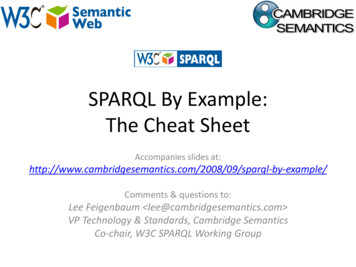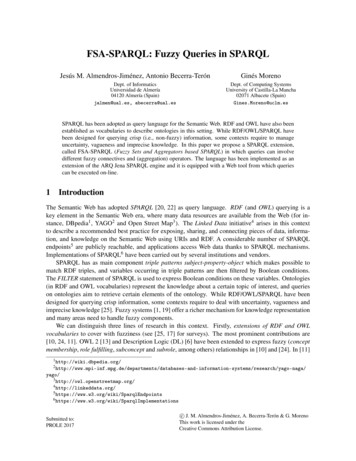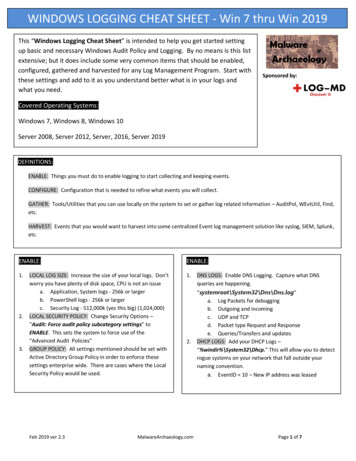
Transcription
SPARQL By Example:The Cheat SheetAccompanies slides l-by-example/Comments & questions to:Lee Feigenbaum lee@cambridgesemantics.com VP Technology & Standards, Cambridge SemanticsCo-chair, W3C SPARQL Working Group
ConventionsRed text means:“This is a core part of the SPARQL syntax orlanguage.”Blue text means:“This is an example of query-specific text orvalues that might go into a SPARQL query.”
Nuts & BoltsURIsWrite full URIs: http://this.is.a/full/URI/written#out Abbreviate URIs with prefixes:PREFIX foo: http://this.is.a/URI/prefix# foo:bar http://this.is.a/URI/prefix#barLiteralsPlain literals:“a plain literal”Plain literal with language tag:“bonjour”@frTyped literal:“13” xsd:integerShortcuts:a Shortcuts:rdf:typetrue “true” xsd:boolean3 “3” xsd:integer4.2 “4.2” xsd:decimalVariablesCommentsVariables:?var1, ?anotherVar, ?and one moreComments:# Comments start with a „#‟# continue to the end of the lineTriple PatternsMatch an exact RDF triple:ex:myWidget ex:partNumber “XY24Z1” .Match one variable:?person foaf:name “Lee Feigenbaum” .Match multiple variables:conf:SemTech2009 ?property ?value .
Common Prefixesprefix. stands om/foaf/0.1/More common prefixes at http://prefix.cc
Anatomy of a QueryDeclare prefixshortcuts(optional)Define thedataset (optional)Query modifiers(optional)PREFIX foo: PREFIX bar: SELECT FROM FROM NAMED WHERE { }GROUP BY HAVING ORDER BY LIMIT OFFSET BINDINGS Query resultclauseQuery pattern
4 Types of SPARQL QueriesSELECT queriesCONSTRUCT queriesProject out specific variables and expressions:SELECT ?c ?cap (1000 * ?people AS ?pop)Project out all variables:SELECT *Project out distinct combinations only:SELECT DISTINCT ?countryResults in a table of values (in XML or daex:Ottawa32,900,000ex:Italyex:Rome58,900,000ASK queriesConstruct RDF triples/graphs:CONSTRUCT {?country a ex:HolidayDestination ;ex:arrive at ?capital ;ex:population ?population .}Results in RDF triples (in any RDF serialization):ex:France a ex:HolidayDestination ;ex:arrive at ex:Paris ;ex:population 635000000 .ex:Canada a ex:HolidayDestination ;ex:arrive at ex:Ottawa ;ex:population 329000000 .DESCRIBE queriesAsk whether or not there are any matches:Describe the resources matched by the given variables:DESCRIBE ?countryResult is either “true” or “false” (in XML or JSON):true, falseResult is RDF triples (in any RDF serialization) :ex:France a geo:Country ;ex:continent geo:Europe ;ex:flag http:// /flag-france.png ; ASK
Combining SPARQL Graph PatternsConsider A and B as graph patterns.A Basic Graph Pattern – one or more triple patternsA . B Conjunction. Join together the results of solving A and B by matching thevalues of any variables in common.Optional Graph PatternsA OPTIONAL { B } Left join. Join together the results of solving A and B by matching thevalues of any variables in common, if possible. Keep all solutions from A whether ornot there’s a matching solution in B
Combining SPARQL Graph PatternsConsider A and B as graph patterns.Either-or Graph Patterns{ A } UNION { B } Disjunction. Include both the results of solving A and the results ofsolving B.“Subtracted” Graph Patterns (SPARQL 1.1)A MINUS { B } Negation. Solve A. Solve B. Include only those results from solving A thatare not compatible with any of the results from B.
SPARQL Subqueries (SPARQL 1.1)Consider A and B as graph patterns.A .{SELECT WHERE {B}}C . Join the results of the subquery with the results of solving A and C.
SPARQL Filters SPARQL FILTERs eliminate solutions that do not cause anexpression to evaluate to true. Place FILTERs in a query inline within a basic graph patternA . B . FILTER ( expr )CategoryFunctions / OperatorsExamplesLogical!, &&, , , ! , , , , ?hasPermit ?age 25Math , -, *, /?decimal * 10 ?minPercentExistenceEXISTS, NOT EXISTSNOT EXISTS { ?p foaf:mbox ?email }SPARQL testsisURI, isBlank,isLiteral, boundisURI(?person) !bound(?person)Accessorsstr, lang, datatypelang(?title) “en”MiscellaneoussameTerm, langMatches,regex(?ssn, “\\d{3}-\\d{2}-\\d{4}”)regex(SPARQL 1.1)
Aggregates (SPARQL 1.1)?key1. Partition results intogroups based on theexpression(s) in theGROUP BY clause2. Evaluate projectionsand aggregate functionsin SELECT clause to getone result per group3. Filter aggregatedresults via the HAVINGclause?val?other114 14 25 24 210 22 21 33 ?key?sum of val1822233?key?sum of val1833SPARQL 1.1 includes: COUNT, SUM, AVG, MIN, MAX, SAMPLE, GROUP CONCAT
Property Paths (SPARQL 1.1) Property paths allow triple patterns to match arbitrarylength paths through a graph Predicates are combined with ath1/path2Forwards path (path1 followed by path2) path1Backwards path (object to subject)path1 path2Either path1 or path2path1*path1, repeated zero or more timespath1 path1, repeated one or more timespath1?path1, optionallypath1{m,n}At least m and no more than n occurrences of path1path1{n}Exactly n occurrences of path1path1{m,}At least m occurrences of path1path1{,n}At most n occurrences of path1
RDF DatasetsA SPARQL queries a default graph (normally) and zero ormore named graphs (when inside a GRAPH clause).Default graph(the merge of zero or more graphs)ex:g1ex:g4Named graphsex:g3ex:g1ORORex:g2PREFIX ex: SELECT FROM ex:g1FROM ex:g4FROM NAMED ex:g1FROM NAMED ex:g2FROM NAMED ex:g3WHERE { A GRAPH ex:g3 { B }GRAPH ?g { C }}
SPARQL Over HTTP (the SPARQL Protocol)http://host.domain.com/sparql/endpoint? parameters where parameters can include:query encoded query string e.g. SELECT *%0DWHERE { default-graph-uri encoded graph URI e.g. http%3A%2F%2Fexmaple.com%2Ffoo n.b. zero of more occurrences of default-graph-urinamed-graph-uri encoded graph URI e.g. http%3A%2F%2Fexmaple.com%2Fbar n.b. zero of more occurrences of named-graph-uriHTTP GET or POST. Graphs given in the protocol override graphs given in thequery.
Federated Query (SPARQL 1.1)Local Graph Storeex:g1SPARQL Endpointex:s1WebSPARQL Endpointex:s2PREFIX ex: SELECT FROM ex:g1WHERE { A SERVICE ex:s1 { B }SERVICE ex:s2 { C }}
SPARQL 1.1 UpdateSPARQL Update Language StatementsINSERT DATA { triples }DELETE DATA {triples}[ DELETE { template } ] [ INSERT { template } ] WHERE { pattern }LOAD uri [ INTO GRAPH uri ]CLEAR GRAPH uri CREATAE GRAPH uri DROP GRAPH uri [ ] denotes optional parts of SPARQL 1.1 Update syntax
Some Public SPARQL EndpointsNameURLWhat’s -purpose queryendpoint for Extensive RDF data fromWikipediaBibliographic data fromcomputer science journalsand ok/snorql/Country statistics from theCIA World tics data fromaround 40 public databasesFilms, actors, directors,writers, producers, etc.
SPARQL Resources The SPARQL Specification– http://www.w3.org/TR/rdf-sparql-query/ SPARQL implementations– http://esw.w3.org/topic/SparqlImplementations SPARQL endpoints– http://esw.w3.org/topic/SparqlEndpoints SPARQL Frequently Asked Questions– http://www.thefigtrees.net/lee/sw/sparql-faq SPARQL Working Group– http://www.w3.org/2009/sparql/wiki/ Common SPARQL extensions– http://esw.w3.org/topic/SPARQL/Extensions
Conventions Red text means: "This is a core part of the SPARQL syntax or language." Blue text means: "This is an example of query-specific text or values that might go into a SPARQL query."










